Substance Abuse or Survival Mechanism?
What the ACE Study Tells Us About – Ourselves … November 8
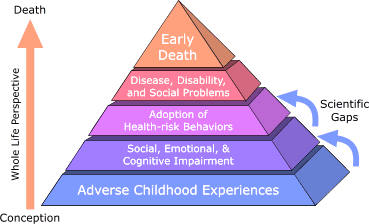 Last Friday Nov. 1, down the road from county Mental Health Services in San Diego, CA, eleven local activists from the mental health, health care, social outreach, and justice systems met for lunch. We discussed the Adverse Childhood Experiences (ACE) Study, research on 17,421 average clients at an average San Diego HMO, who were simply asked if they’d had bad childhood experiences, physical or emotional. The study compared their childhoods, to whether they later developed life-threatening physical medical conditions and/or addictions.
Last Friday Nov. 1, down the road from county Mental Health Services in San Diego, CA, eleven local activists from the mental health, health care, social outreach, and justice systems met for lunch. We discussed the Adverse Childhood Experiences (ACE) Study, research on 17,421 average clients at an average San Diego HMO, who were simply asked if they’d had bad childhood experiences, physical or emotional. The study compared their childhoods, to whether they later developed life-threatening physical medical conditions and/or addictions.
The data revealed staggering proof of the health, social, and economic risks that result from childhood trauma. It showed that such trauma and its consequent serious medical issues affect over 50% of the population of the U.S. The ACE Pyramid shows that Adverse Childhood Experiences often lead to impaired thinking, unhealthy behavior, life-threatening disease, and are topped off by early death.
The ACE Study participants are mostly middle-class, college-educated HMO clients. Two-thirds (64-67%) had one or more types of childhood trauma, and 38-42% had two or more types. One in six had an ACE score of 4 or more, and one in nine had an ACE score of 5 or more. Child trauma and its lethal results affect an unknown higher percent of Americans raised in poverty. A national average of all economic groups would likely show 50% or more suffer severe trauma from ACEs.
This is not an issue to which one might donate at Christmas, then forget. This could well be about you and your family, and almost any American. So why are you and your family in the dark?
How can almost 20 years of official study on 17,421 people be so far under our radar? The ACE Study began in 1995 at Kaiser Permanente, the largest HMO in California, as joint research with the U.S. government Centers for Disease Control (CDC). First results were reported in the 1998 American Journal of Preventive Medicine by chief investigators Dr. Vincent Felitti MD of Kaiser, Dr. Robert Anda, MD of CDC and their colleagues, and have appeared in over 60 medical journals. [FN1]
The public info gap is not for lack of alarm-ringing. Drs. Felitti and Anda, who started as curious scientists and became passionate advocates, have burned the global lecture circuits. ACEsConnection, its news site ACEsTooHigh and their creator, science journalist Jane Ellen Stevens, have spent the last eight years knocking on national media doors and spurring grassroots education. [FN2]
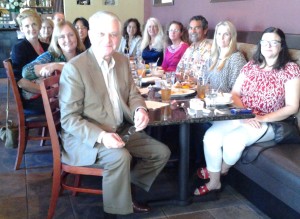 Our Nov. 1 lunch was the first meeting of “SoCal ACEs,” the Southern California chapter of ACEsConnection, started by another career writer, me, with Jane’s help. We’re all passionate about ringing the alarm. While we were passionately passing the curry, in walked Dr. Vincent Felitti himself, much to our surprise.
Our Nov. 1 lunch was the first meeting of “SoCal ACEs,” the Southern California chapter of ACEsConnection, started by another career writer, me, with Jane’s help. We’re all passionate about ringing the alarm. While we were passionately passing the curry, in walked Dr. Vincent Felitti himself, much to our surprise.
“Public Health Problems – or Personal Solutions?”
Dr. Felitti made some eye- opening comments to our SoCal ACES lunch, remarks he’s made before in speeches, DVDs, and videos released by the CDC and other agencies. [FN3] Yet since so few have gotten his message, it’s necessary to repeat his comments, and flatly state the implications. Sometimes a badly needed wake-up call can feel as if it were in-your-face. Sorry to play Paul Revere, but we can do plenty about this – if we have the courage to get to the bottom of it and think it through.
Based on the ACE Study statistics, Dr. Felitti said, “The risk factors which can be attributed to Adverse Childhood Experiences include… about 2/3 of all alcoholism, about half of all drug abuse, and about 3/4s of intravenous drug use (in the U.S.). These are the risk factors that underlie the 10 most common causes of death in the United States. With an ACE score of zero,” he notes, “You have a very medically un-interesting population: non-obese, non-smoking, non-alcoholic, non-diabetic, non-hypertensive. No internist has a chance of making a living with that group. But with an ACE score of 4 or more, this is big medicine!
“And,” Dr. Felitti continued, “the things that we call ‘risk factors’ are in fact, effecting coping devises. This is an important idea.
“Many of these things termed ‘public health problems’ are in fact, personal solutions. Personal solutions to problems (ACE) that are well-hidden, by time, by shame, by secrecy, by social taboo (many child traumas are sexual, physical, and emotional hidden for a lifetime).
“Public health problem = personal solution? That’s a pretty heavy-handed statement, but I feel very comfortable making it…
“This is what psychoanalysts have been saying for a hundred years; but they’ve been saying it based on two cases or four – and we’re saying it based on 18,000 cases. One way of describing it would be: you have this large base of individuals with Adverse Childhood Experiences, and most of them are going to be impaired as a result in some way, maybe socially, maybe emotionally, maybe cognitively…
 “By the time they become adolescents and have some freedom, they ordinarily will try to do something to feel better, and hence initiate what we call health-risk behaviors, but which might be called more properly ‘self-help behaviors.’ Those, over time, will produced disease and disability in many of them, and a significant portion of them will die early,” as the ACE pyramid shows. (‘Early Death’ being the top of the pyramid.) [ FN4]
“By the time they become adolescents and have some freedom, they ordinarily will try to do something to feel better, and hence initiate what we call health-risk behaviors, but which might be called more properly ‘self-help behaviors.’ Those, over time, will produced disease and disability in many of them, and a significant portion of them will die early,” as the ACE pyramid shows. (‘Early Death’ being the top of the pyramid.) [ FN4]
“Swiss psychoanalyst Alice Miller says: ‘The truth about our childhood is stored up in our bodies, and lives in the depths of our souls’,” Dr. Felitti ended. ” ‘Our intellect can be deceived, our feelings can be numbed and manipulated, our perceptions can be shamed and confused, our bodies tricked with medication. But our soul never forgets. And because we are one whole soul in one body, some day our body will present its bill.’
“In this study, we are looking at it literally. The cost of this is truly enormous. Whoever would have thought that pediatrics, is the breeding ground for internal medicine.”
The ACE Study “provides more understanding about the lives of hundreds of millions of people around the world who use biochemical coping methods – such as alcohol, marijuana, food, sex, tobacco, violence, workaholism, methamphetamines, thrill sports – to escape intense fear, anxiety, depression, anger,” as Jane Stevens told the Huffington Post. Such compulsive forms of self-abuse, also including internet porn and more, are endemic to every income bracket.
“Public health experts, social service workers, educators, therapists and policy makers commonly regard addiction as a problem,” she writes. “Some, however, are beginning to grasp that turning to these drugs is a normal response to serious childhood trauma, and that telling people who smoke or overeat or overwork that these are bad for them and that they should stop, doesn’t register when those approaches provide a temporary, but gratifying solution.” [FN5]
Trauma and Survival
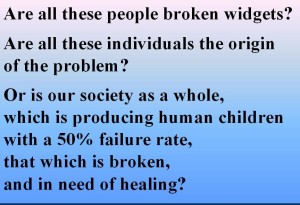 Do all these individuals “just happen” to be broken? Are they the problem? Or at least, are they mere individual problems?
Do all these individuals “just happen” to be broken? Are they the problem? Or at least, are they mere individual problems?
Or is our society as a whole, which is producing human
children with a 50% or higher failure rate, the thing which needs major policy changes and a great deal of healing?
To be clear: this is not to condone, aid, or abet the abuse of
alcohol, marijuana, food, sex, tobacco, violence, workaholism,
methamphetamines, internet porn, thrill sports, and many
more. No need for right or left wing to get on a soap box.
Nevertheless the real question now is: what if all this substance abuse, and the disease, broken families, crime, and other tragedies which flow from it, is in scientific fact, a survival mechanism?
What if the human organism, when subjected to the childhood traumas reported in the ACE Study, reacts with these addictions as a form of sheer biological and physiological necessity? What if these behaviors turn out to be necessary for the raw survival of each separate traumatized individual being turned loose to fend for his or her self under current conditions in this country?
Consider their alternative. Let’s not condone “Early Death” for millions.
One consulting engineer told me, “We’ve tried everything based on the assumption that ‘they’ are the broken widgets. But what we’re doing isn’t working, because we’re just producing more and more broken widgets. Einstein’s definition of insanity is repeating the same procedure and expecting to get a different outcome. Engineering science says at this point in any process, that it’s our assumptions and axioms which are wrong and we need a paradigm shift.”
Let’s define “Adverse Childhood Experience.” Just as everyone should know their cholesterol score, everyone should know their ACE score. Take the ACE Questionnaire from the Centers for Disease Control, the same questions used on the ACE Study and in follow-on ACE Surveys done by 21 states and several nations globally.
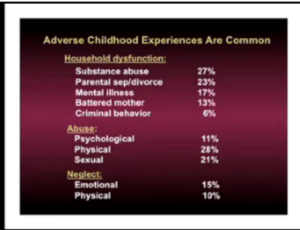 It asks about 10 types of childhood trauma. The first five questions are personal: Did you suffer childhood sexual abuse, physical abuse, physical neglect, verbal abuse, or emotional neglect? The last five relate to family: Did you have a family member in jail, a family member with mental illness, a mother suffering domestic violence, an alcoholic parent, or a parent who disappeared?
It asks about 10 types of childhood trauma. The first five questions are personal: Did you suffer childhood sexual abuse, physical abuse, physical neglect, verbal abuse, or emotional neglect? The last five relate to family: Did you have a family member in jail, a family member with mental illness, a mother suffering domestic violence, an alcoholic parent, or a parent who disappeared?
Medical doctors – and most Americans – long assumed “these things” are products of poverty and violence. Yes, these things are scary: childhood sexual abuse, physical abuse, physical neglect, family members in jail, with mental illness, or domestic violence — and often assumed to be the effects of poverty. So government, social agencies and others have focused on the basic physical needs of poor families for food, clothing, shelter, health, education, etc. It was and is still necessary. But not sufficient.
Doctors also assumed “these things” rarely if ever happen to middle-class, college-educated folk such as the 17,421 ACE Study participants – all of whom had jobs and great health care or they wouldn’t be in Kaiser Permanente! As Dr. Felitti puts it, “nice people don’t ask about these things, and most doctors are nice people.”
But “these things,” the ACE Study reveals, do happen in middle/ upper-class families – 40-60% of the time. Childhood sexual abuse, and physical abuse may be scary – but they happen in higher income brackets. Verbal abuse and emotional neglect? Many higher income families dismiss these as unimportant – they happen all the time. Kids are told to “suck it up,” behave and achieve since others are worse off.
A mother suffering domestic violence, an alcoholic parent? Not unheard of in well-off suburbia. A family member with mental illness? Most middle income folk growing up in the 1960s or 70s – like the ACE Study participants — never heard of Bi-Polar, Borderline Personality Disorder, or such, and never asked if a parent had it. Yet many parents did, we now know. Parents who disappear? Death, divorce, and walk-outs do happen here. But more widespread “disappearance” takes many forms usually dismissed as unimportant: parents who are physically around but mentally out to lunch, unable to handle emotional connection (tech term “attunement”), always stressed out, or plain hostile to kids.
Thus we arrive at today, with “these things” of childhood ACE trauma occurring in half of higher income brackets and surely a far higher percent of lower income brackets – still most doctors don’t ask. “These things” are not discussed – and considered irrelevant to medicine.
Don’t worry, we’ll get to “What to Do” (Harvard’s working on it).
But first, let’s nail down the fact that the ACE issue is every family’s problem, not some issue about “them.” Let’s take this up close and personal. Let me tell you a bit of my story.
The Heartbreak ACE of Attachment Disorder
This is not an academic issue to me. I had a 30-year career in the fast lanes of New York City and Washington DC, as an economist for 18 years in New York, then in Washington as a technical writer. There I produced complex documents for Pentagon subcontractors for 12 years, while pursuing my hobby as an opera singer. I was too busy flying around the world to have children and build a family.
Suddenly in 2007, I faced divorce from a 27-year marriage to my college sweetheart, leaving me bankrupt. A move to California was followed by the death of both my parents in 2008 and then two bad rebound affairs – five life disasters in two years. My persona cracked wide open and there was nothing inside, so I took myself to therapy.
I learned that I was an unwanted pregnancy, born with a terrible infection which nearly killed both my mother and me, and incubated at birth for numerous weeks. But my first two therapists in 2008-2009 were about as good at healing as Torquemada. They had no insight into the topics in this article and never mentioned the ACE Study, what my post-natal experience might mean, or even the word “trauma.” In fact, I was a patient in Kaiser Permanente in Anaheim, CA for two years after that, working nearby. I even made an appointment with a (third) Kaiser therapist, but left when she had nothing to say. No one ever mentioned the ACE Study.
 In 2011 I heard about “Adult Attachment Disorder” at a church meeting (sic), and decided that was me. I began researching attachment and brain science, and writing a book about my experience. “Science has only recently demonstrated that unless kids are given deep emotional connection (‘attachment’) from birth by parents or other humans, infant neurological systems don’t develop well. They can now do brain scans showing that chunks of neurons in some brain regions don’t fire; it’s dark in there,” I wrote. It’s called “in-secure attachment” or attachment disorder.
In 2011 I heard about “Adult Attachment Disorder” at a church meeting (sic), and decided that was me. I began researching attachment and brain science, and writing a book about my experience. “Science has only recently demonstrated that unless kids are given deep emotional connection (‘attachment’) from birth by parents or other humans, infant neurological systems don’t develop well. They can now do brain scans showing that chunks of neurons in some brain regions don’t fire; it’s dark in there,” I wrote. It’s called “in-secure attachment” or attachment disorder.
I figured out myself that my persistent feeling that “parts of my brain were dark” had been a result of my incubation. Later in 2011 a fourth and competent therapist finally confirmed it. Much later in March 2013, I was at a conference where Dr. Bruce Perry, MD of the Child Trauma Academy in Houston, showed these brain scans. The scan at above right is of a normal 3-year old; the scan at left, of a 3-year old with attachment disorder. Parts of it are dark. That hurt.
I went to attachment and brain science conferences, and bought every book I could get by Judith Herman, Ruth Lanius, Daniel Siegel, Allan Schore, Bruce Perry, Bessel van der Kolk, Peter Levine, and so on. Check the footnotes in my book blogs.
Deluged with the bad news about my brain, at some point I dimly recalled that Dr. Perry had also mentioned something called the ACE Study, so I Googled it and logged into ACEsConnection. The first thing I saw was a video of a baby in a Polish orphanage that turned my heart and digestive tract inside out.
 Brace yourself before you watch – this is what the physical pain of attachment failure looks like. (Click the link above and scroll down to this photo). Left alone for weeks or months in the under-staffed Warsaw facility, Baby Casey did not get the “face time,” physical holding, emotional attunement, or any of the millions of interactions required for an infant’s brain to grow. [FN6]
Brace yourself before you watch – this is what the physical pain of attachment failure looks like. (Click the link above and scroll down to this photo). Left alone for weeks or months in the under-staffed Warsaw facility, Baby Casey did not get the “face time,” physical holding, emotional attunement, or any of the millions of interactions required for an infant’s brain to grow. [FN6]
Humans, from the instant of birth, require a constant stream of “emotional, spiritual, psychological, and physical inputs” from another loving human, says Dr. Mary Jo Barrett of the University of Chicago — just as we require air, food, and liquid. “Complex or developmental trauma is about traumatic interruptions [of that stream],” she notes. “I from birth…have a series of relationships where I am emotionally, spiritually, physically vulnerable… If my spirit, my emotional stability is endangered, my physical being, is endangered, if I am repeatedly interrupted in the context of these relationships, these repetitions create a person who spends their life in fight, flight or shut down.” [FN7]
A child left without this input stream learns that its own hard-wired biological needs are terrifying. “I learn that what I experienced internally and expressed externally with a cry, was met by a response that didn’t make any sense to what I needed,” says Dr. Daniel Siegel, MD of UCLA. “The organization of that child’s brain will be quite different, as neurons which fire together, wire together.
“I will have learned: it doesn’t matter what I’m feeling, because people don’t get me what I need. So I’ll learn to live without calling out to other people, and studies show, as I have those experiences over and over again, I will actually have a different way of being in the world. Ultimately, I’ll become quite disconnected, not only from other people, but even from my own internal bodily self and my emotional experience. ” [FN8]
The emotional pain and terror are so intense, the child will do anything to distract itself from those screaming needs. “In this distress I can only comfort myself in ways that are often maladaptive – I may bite myself, I may rock myself perpetually, trying to distract myself from my needs,” Dr. Siegel states. Such children “have all sorts of self-regulatory processes that are not interpersonal. They are very isolated.”
The fight-or-flight stress chemicals flood the bloodstream at a level which feels so terrifying, the baby would rather pass out — or die — than feel it. “The baby thinks it’s going to die,” Dr. Nancy Verrier says. [FN9]
I saw Baby Casey and said, “She’s trying to knock herself out.” How many times have I felt that in the last few years: “The baby thinks it’s going to die” becomes “I feel like I want to die.”
“From the very beginning to the very end of our lives together, Casey suffered from violent and debilitating rages and temper tantrums,” her father John Brooks writes in his new book “The Girl Behind The Door.” “The ‘experts’ told us she’d grow out of it; we just had to be tougher with her. How clueless they – and we – were.” Despite loving parents and a beautiful home, Casey and her family were unaware of the enormity of her buried emotional pain. Casey took her own life at 14.
Why Do We Drink?
We’ve just detoured to the “attachment” ball park to gather a wider set of data on Dr. Felitti’s original Big Question:
Do so many Americans use alcohol, tobacco, marijuana, meth, IV drugs, food, sex, violence, workaholism, sports, internet porn, etc. for sheer survival? Are they compelled to medicate with these to escape an intense fear, anxiety, depression, or anger which if they had to feel it, might literally kill them — by body part failure or suicide? Suicide rates are abnormally high in the ACE population; compared to ACE Study participants with zero ACE traumas, those with four ACEs are 12 times more likely to attempt suicide.
Are the high-ACE folks who want to avoid suicide, doing things sure to cause “early death” in a few years or decades, as the ACE Pyramid shows, in order not to die now? That’s one way to do “survival.”
I’ve learned the hard way that if we want to help sick people (and Lord knows I’ve been one), we’ve got to get at the science of what drives them. We’ve got to deal in reality, not prejudice.
So here’s what Attachment Theory and brain science say about attachment and substance abuse like alcohol.
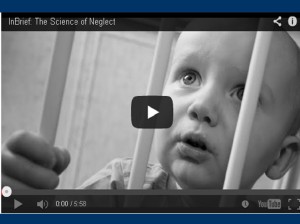 “At birth we are biologically waiting for input from adults around us to ‘serve and return,’ a back and forth interaction that literally shapes the architecture of the infant brain,” report Dr. Jack Shonkoff, M.D., Director of Harvard’s Center on the Developing Child and his colleagues in a 2012 video “The Science of Neglect.” “It begins when a child looks at something, observers something, that’s the serve. The return is when the parent responds to the child. When serve and return is broken, you literally are pulling away the essential ingredients for the development of human brain architecture… When a baby is not attended to, that is a sign of danger to the baby’s biological systems, so its stress systems are activated. In a brain that is constantly bathed in stress hormones, key synapses, the connections between nerves, fail to form in critical regions of the brain.” [FN10]
“At birth we are biologically waiting for input from adults around us to ‘serve and return,’ a back and forth interaction that literally shapes the architecture of the infant brain,” report Dr. Jack Shonkoff, M.D., Director of Harvard’s Center on the Developing Child and his colleagues in a 2012 video “The Science of Neglect.” “It begins when a child looks at something, observers something, that’s the serve. The return is when the parent responds to the child. When serve and return is broken, you literally are pulling away the essential ingredients for the development of human brain architecture… When a baby is not attended to, that is a sign of danger to the baby’s biological systems, so its stress systems are activated. In a brain that is constantly bathed in stress hormones, key synapses, the connections between nerves, fail to form in critical regions of the brain.” [FN10]
And the flood of stress chemicals doesn’t just stop. It can go on for years and decades, biology gone haywire. Bruce Perry explains it in terms of how the three regions of the brain react. His slide below shows the highest thinking “cortex” level of the brain in blue, the next higher emotional-attachment-relational “limbic’ brain in green, and the lowest survival brain, aka reptilian brain, made up of the cerebellum and the brain stem, the foundation of the entire brain, in yellow and red.
The survival brain doesn’t think and it has no feelings for others. It’s only job is to keep our breathing, heart beat, and basic functions going so we survive. “We run into three things that cause developing brain neurons to get screwed up, causing across the board developmental trauma,” Perry said in March at UCLA.
“1. Intra-uterine insult – stress, threat to the mother, or 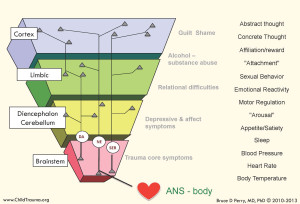 substance abuse by the mother adversely effect brain neurons. In particular, the brain stem (survival brain) must be organized before you are born. So there is a lot of activity there and it’s the most vulnerable part of the brain in the womb. With stress in utero, we have a cascade of mental and physical problems in every part of the body and brain. Brain stem neural networks organize before birth and influence every part of the brain, so every part of the brain will be dysreglated.
substance abuse by the mother adversely effect brain neurons. In particular, the brain stem (survival brain) must be organized before you are born. So there is a lot of activity there and it’s the most vulnerable part of the brain in the womb. With stress in utero, we have a cascade of mental and physical problems in every part of the body and brain. Brain stem neural networks organize before birth and influence every part of the brain, so every part of the brain will be dysreglated.
“2. Disrupted Attachment: If you disrupt post-natal bonding, if the caregiver is not capable of attuned, regulated care giving, all these brain networks will be dysregulated.
“3. Post-natal Trauma such as violence in the home. With all three, we have a 100% prospect that this child’s going to be dysregulated,” Perry stated. “But because of the way we’ve ‘invented’ our health service delivery models, the pediatrician treating his asthma won’t make the connection to his intra-uterine insult. The psychiatrist will just give him ritalin and whatever the drug rep tossed on his desk.”
So why do people drink?
“We can’t persuade people with developmental trauma with a cognitive argument (cortex brain), or compel them with an emotional affect (limbic brain), if their brain stem (survival brain) is dysregulated,” Perry warns. “We can’t talk people in this kind of alarm state into doing the right thing, because their thinking brain’s been turned off by the alarm state. And we can’t reach their emotional-attachment-relational (limbic) brain if they feel so threatened they get into an alarm state, because they can’t feel reward from relations with people.
“If their brain stem, the foundation of their entire brain as a whole, is completely dysregulated, the only way they can feel reward is from sweet/salty/fatty foods, alcohol, drugs, sex, and so on. They know in their head that it’s wrong to steal from Grandma, and they may love Grandma in their heart – but at that moment, cognitive beliefs, or even human relational consequences, can’t relieve their anxiety. They are in such distress in the lowest parts of their survival brain that it (survival brain) needs the reward of the drugs too badly.
“In fact, they can get to the point where they can’t feel any reward at all – reward can’t even reach the lower part of the brain, if they’re so ramped up and anxious. At that point, the ONLY thing they want is to relieve the distress, and the only thing that can do it is to drink. Alcohol will reduce the anxiety. It also makes us more vulnerable to other unhealthy forms of rewards.” [FN 11]
When Vincent Met Mary: Survey Says
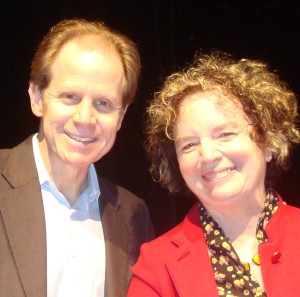 Like ACE trauma, Attachment Disorder has also been demonstrated to affect 50% of Americans – but completely independently. That’s why I have a “bucket list” item to see that Dr. Vincent Felitti’s been introduced Dr. Mary Main of the University of California, Berkeley, shown here with Dr. Dan Siegel at UCLA.
Like ACE trauma, Attachment Disorder has also been demonstrated to affect 50% of Americans – but completely independently. That’s why I have a “bucket list” item to see that Dr. Vincent Felitti’s been introduced Dr. Mary Main of the University of California, Berkeley, shown here with Dr. Dan Siegel at UCLA.
British psychiatrist John Bowlby developed Attachment Theory in the 1950s. [FN12] In 1978 Bowlby’s American co-worker Mary Ainsworth showed that the way an infant behaves with strangers when its mother leaves, shows the quality of mothering it’s getting — and predicts its emotional traits for life. Ainsworth wrote that 69% of children are “securely attached” to mom. [FN13]
In 1982, Ainsworth’s student Mary Main and her own students created the Adult Attachment Interview (AAI). This interview shows (with 79%+ accuracy!) how securely attached they got as kids. It also remarkably predicts what kinds of relations they have as adults with co-workers, dates, and mates. [FN14] Dr. Main concluded by 1996 that only 55% of Americans are in fact securely attached, and Dr. Ainsworth agreed. That’s a shocking low number; it says 45% have some attachment disorder.
Now take the radical changes since 1996 in how humans relate, since the rise of cell phones, texting, the internet and its electronic “social” networking. There’s nothing social about it.
“Well-developed human beings can self-regulate their emotional state by being with other humans,” top neuro-scientist Dr. Stephen Porges says. “But what about people who regulate their emotional state with objects?…We’re in a world now being literally pushed on us, by people who are challenged in their social regulation, and we’re calling this ‘social networking.’ We’re using computers, we’re texting — we’re stripping the human interaction from all interactions… We’re allowing the world to be organized upon the principles of individuals who have difficulty regulating emotionally in the presence of other human beings.” [FN15]
Three specialists who have seen a large volume of patients over almost 20 years’ clinical experience since 1996 have confided their concern to me in person this year, that with people spending so much more time online, texting, on the phone, etc, rather than face to face, we’re lucky if we’ve got 40% securely attached these days. That would mean 60% by now have some attachment disorder.
So do 45% or 60% of Americans have some attachment disorder? Unclear, but 50% is a reasonably conservative estimate.
Now: what if the 17,400 ACE Study participants were to be given Dr. Mary Main’s Adult Attachment Interview? Might there be a correlation between the 38-42% of ACE participants with two or more ACE incidents, and the general population’s 45% score for insecure attachment?
You can already hear 1980s TV show “Family Feud” host Richard Dawson shouting: “Survey Says!”
“Addiction as an Attachment Disorder”
Attachment disorder is surely a major component of many Adverse Childhood Experiences.
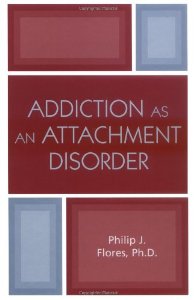 As to ACEs and substance abuse, note Dr. Philip J. Flores’ 2004 book entitled “Addiction as an Attachment Disorder.”
As to ACEs and substance abuse, note Dr. Philip J. Flores’ 2004 book entitled “Addiction as an Attachment Disorder.”
Dr. Flores reports that the human need for social interaction is a physiological one, linked to the well-being of the nervous system, as we’ve already seen. When someone becomes addicted, he says, mechanisms for healthy attachment are “hijacked,” resulting in dependence on addictive substances or behaviors. Flores believes that addicts, even before their addiction kicks in, struggle with knowing how to form emotional bonds to connect to other people.
Co-occurring disorders, such as depression and anxiety, make it even harder to build those essential emotional attachments. “We, as social mammals, cannot regulate our central nervous systems by ourselves,” Flores said. “We need other people to do that.” That’s Attachment Theory 101.
While it’s commonly understood that early childhood attachments to parents and family are necessary for healthy development, Flores says, emotional attachments remain necessary throughout adulthood. It’s not enough, he says, to “just stop drinking. ” To achieve long-term well-being, addicts need opportunities to forge healthy emotional attachments.
Flores reports that this is the reason for the phenomenal success rate of Alcoholics Anonymous over more than 50 years. When people walk into an A.A. meeting, the whole point is to admit openly that they are an alcoholic and yet to feel fully accepted for exactly who they are, with no condemnation. What a relief! This experience of, in essence, pure attachment, may be the best attachment experience in their lives – and most people who walk in and experience this, miraculously, stay sober for decades or a lifetime.
“What A.A. does… is what good psychotherapy does,” says Flores. It provides “a community for people to break their isolation and start to connect on an emotional level with other people.” [FN16 ]
Dr. Flores’ study is one of many cited in “Does Science Show What 12 Steps Know?” — a lengthy feature in the August 2013 National Geographic about the use of solid human emotional attachment to heal addiction behavior. [FN17]
If most addictions are caused by the way in which attachment disorder underlies many ACEs, now we know what to do.
Heal the Adults, Heal the Children
To the extent the ACE Study, attachment disorder, and the biology of brain stem dysregulation have become understood in the last ten years, many alarmed at this have focused on creating “preventative programs” to alert parents to be more attentive to their infants and to these issues. By itself this is necessary.
But again, it’s not sufficient. Here’s the major problem: if half of today’s parents themselves, like so many adult ACE Study participants, have moderate to severe brain stem trauma, will pamphlets, on-line seminars and Facebook campaigns do it? What do we do about all the attachment disorder in adults?
In just one example of many, several experts report that the infant brain, from conception and early cell division, must divide cells and grow based on some kind of rhythm, and for nine months it is driven to tune on a cellular level to its mother’s heart and breathing rates, among her other vitals. “We have a pregnant employee who’s an athlete who’s resting heart rate is 40 beats/minute; she’s likely to have a very relaxed baby who likes relaxed rhythms. And a hyper-thyroid mother whose heart rate is 95 may have a baby who finds a higher regulating rhythm,” Bruce Perry reports.
But a mother with ACE trauma herself, hysteria, or any high stress often has “a totally irregular heart rate, breathing and other vital signs,” he notes. “These moms end up with kids who are difficult to sooth because the mother had no rhythm consistently present for them to entrain to in utero. After birth, they can’t find any rhythm that is soothing.” [FN18]
No amount of public information is going to solve this problem for this mother or her baby. Such mothers themselves, even the most determined to love their baby, require deep psychological and biological healing for their own trauma. That is often true for fathers who marry such women as well.
Dr. Joanne Loewy, Director of the Louis Armstrong Center for Music & Medicine at Beth Israel Medical Center in New York, and her colleagues nationally, have published extensively on the superiority of lullabies which are personally recorded by the parent (versus pre-recorded music) to sooth preemies and term babies born with other need for ICU or incubation stays. [FN19]
But if a mother isn’t “attuned” inside herself, how can she truly attune to her baby? I had so little ability to attune to a baby in my 20s and 30s that I literally “didn’t even have it in me” to have children. “I would have thought the very idea would have been absolutely terrifying to you,” my last therapist said (I finally found a good one). Without far-reaching programs to heal the parents, many will remain biologically incapable of attuning to children.
It’s Adult Attachment Disorder which is the underlying cause of childhood trauma – not babies.
 In his video “Building Adult Capabilities to Improve Child Outcomes: A Theory of Change,” Dr. Jack Shonkoff at the Harvard University Center on the Developing Child explains this to a degree. He notes that programs to distribute information and advice to parents and caregivers have limited effect. Dr. Shonkoff calls for active training of the adults on focusing attention, working in teams, and regulating their own emotions. This is a good start. [FN20]
In his video “Building Adult Capabilities to Improve Child Outcomes: A Theory of Change,” Dr. Jack Shonkoff at the Harvard University Center on the Developing Child explains this to a degree. He notes that programs to distribute information and advice to parents and caregivers have limited effect. Dr. Shonkoff calls for active training of the adults on focusing attention, working in teams, and regulating their own emotions. This is a good start. [FN20]
But it took deep emotional attachment to heal the adult me over the last years. It required a broad safety net: an empathic, painstaking therapist skilled in Adult Attachment Theory; support groups modeled on the A.A. principle of total acceptance and emotional attachment for the wounded; and close friends who were serious about staying attached to me because they wanted to heal, too.
As Dr. Felitti told me November 1 in San Diego, “After we talked to the very first round of ACE Study participants about their childhood experiences in the results of their ACE questionnaires, we saw a staggering 20% or higher reduction in the number of medical complaints, office visits, and other indicators of physical ailments in the next year alone. Over and over, people thanked us for simply listening to them and their stories.”
“I want to thank you for caring enough about people to read all those charts and find out what happens to all of us who are molested, raped and abused in childhood,” one ACE participant wrote to Dr. Felitti. “I suffered for years. The pain became so great I was thinking of jumping off the San Diego Bay Bridge… How many people may have taken their life because they had no program to turn to? How many lives can be saved by this program?”
That’s human emotional attachment: being seen, being known, just as we are, warts and all, by another human being – and then being fully accepted, and finally feeling that we belong.
Any wonder that “Avatar” was such a hit, when at the end the![]() giant Na’vi heroine Neytiri picks up her fiancee Jake with his tiny, crippled, broken body in one hand, looks into his eyes, and says “I see you?” In Na’vi that means: “I see your soul, and I love you for who you truly are. You really belong now.”
giant Na’vi heroine Neytiri picks up her fiancee Jake with his tiny, crippled, broken body in one hand, looks into his eyes, and says “I see you?” In Na’vi that means: “I see your soul, and I love you for who you truly are. You really belong now.”
People have an enormous craving to be accepted for who they really are and to feel they truly belong, without having to fear all the stress of performance to earn a little affection or condemnation of their warts. That longing seems to be going unsatisfied in the lives of, gosh, would that be about 50% of Americans?
Just what the Harvard study said an infant needs for brain development: attunement. Just what some 50% of us apparently did not experience enough as infants and children – for babies do all sorts of things which are far from perfect! Yet we needed to feel accepted and to belong, to grow out of it.
This is what Dr. Felitti, Dr. Anda and company gave their ACE Study participants by simply listening to their terrible stories for the first time in their lives. From all these experiences, we can begin to craft a program broad enough to heal.
Footnotes
FN1 Felitti VJ, Anda RF, Nordenberg D, Williamson DF, Spitz AM, Edwards V, Koss MP, Marks JS, “Relationship of childhood abuse and household dysfunction to many of the leading causes of death in adults: The Adverse Childhood Experiences (ACE) Study,” American Journal of Preventive Medicine 1998;14:245–258. http://www.ncbi.nlm.nih.gov/pubmed/9635069?dopt=Abstract
FN2 They’ve gotten articles into the New York Times in Sept. 2012 and just this past October 30, as well as in Salon, This American Life Radio, and more. See David Brooks, “The Psych Approach,” Sept 27, 2012; www.nytimes.com/2012/09/28/opinion/brooks-the-psych-approach.html?_r=0
Thomas Rogers, “How stress is really hurting our kids: New science shows that childhood trauma can cause cancer, heart disease and other problems,” Jan 2, 2012 www.salon.com /2012/01/02/how_stress_is_really_hurting_our_kids/
David Bornstein, “Protecting Children From Toxic Stress,” Oct. 30, 2013, http://opinionator.blogs.nytimes.com/2013/10/30/protecting-children-from-toxic-stress/?_r=0
FN3 Dr. Felitti made the same remarks as those quoted here from his 13-minute video “Adverse Childhood Experiences” at www.youtube.com/watch?v=GQwJCWPG478
FN4 Centers for Disease Control (CDC), “ACE Study DVD Pre-View movie,” http://www.youtube.com/watch?v=v3A_HexLxDY
FN5 Jane Ellen Stevens, “The Adverse Childhood Experiences Study: The Largest, Most Important Public Health Study You Never Heard of, Began in an Obesity Clinic,” original in Huffington Post, Oct. 8, 2012, Part 1 of 3: http://www.huffingtonpost.com/jane-ellen-stevens/the-adverse-childhood-exp_1_b_1943647.html
FN6 John Brooks, “Video of Baby Casey in the Orphanage,” Warsaw, Poland, 1991, from “The Girl Behind the Door: An Adoptive Father’s Lessons Learned About Attachment Disorder,” at http://parentingandattachment.com/the-girl-behind-the-door/. Original video: http://parentingandattachment.com/meet-my-casey/.
FN 7 Barrett, Mary Jo, MSW, “How to Treat the Patient Without Further Trauma,” June 29, 2011 webinar, NICABM.com. She is professor at the University of Chicago, founder and director of the Center for Contextual Change, co-author of “Systemic Treatment of Incest,” and co-editor of “Treating Incest: A Multiple Systems Perspective.”
FN8 Siegel, Daniel J., MD, “Early childhood and the developing brain,” on “All in the Mind,” ABC Radio National, Radio Australia, June 24, 2006: www.abc.net.au/rn/allinthemind/stories/2006/1664985.htm
FN9 Verrier, Nancy PhD., “Coming Home to Self: The Adopted Child Grows Up,” self-published, Lafayette, CA, 1993
FN 10 Harvard University Center on the Developing Child, “The Science of Neglect: The Persistent Absence of Responsive Care Disrupts the Developing Brain: Working Paper 12,” 2012, www.developingchild.harvard.edu. Accompanying video “InBrief: The Science of Neglect” and PDF summary at http://developingchild.harvard.edu/resources/multimedia/videos/inbrief_series/inbrief_neglect/
by Jack P. Shonkoff, M.D., Director Harvard University Center on the Developing Child & Harvard Medical School Professor of Pediatrics; Linda C. Mayes, MD, Yale University School of Medicine; et. al.
FN11 Perry, Bruce MD, “Born for Love: The Effects of Empathy on the Developing Brain,” speech at conference “How People Change: Relationship & Neuroplasticity in Psychotherapy,” UCLA Extension, Los Angeles, March 8, 2013. See also “Overview of Neuro-sequential Model of Therapeutics (NMT)” at www.childtrauma.org, 2010
FN12 Bowlby, John, “The Nature of a Child’s Tie to His Mother,” British Psychoanalytical Society, London, 1958; “Attachment and Loss,” New York, Basic Books, 1969
FN13 Ainsworth, Mary D.S., Blehar, M.C., et al, “Patterns of attachment: A psychological study of the Strange Situation,” Erlbaum, Hillsdale, NJ, 1978
FN14 For articles and documentation by Mary Main and background on the AAI, see “The Adult Attachment Interview (AAI): Mary Main in a Strange Situation,” at http://attachmentdisorderhealing.com/adult-attachment-interview-aai-mary-main/
FN15 Porges, Stephen, PhD: – On Social Neworking: page 15 of his April-June 2012 webinar: “Polyvagal Theory,” http://www.stephenporges.com/images/NICABM%20April%202012.pdf
– Overview of his work, 2013: “Body, Brain, Behavior: How Polyvagal Theory Expands Our Healing Paradigm,” NICABM Webinar, http://stephenporges.com/images/NICABM%202013.pdf
– On Trauma, 2013: “Beyond the Brain: How the Vagal System Holds the Secret to Treating Trauma,” http://stephenporges.com/images/nicabm2.pdf
– Academic background, 2001: “The polyvagal theory: phylogenetic substrates of a social nervous system,” International Journal of Psychophysiology 42 Ž, 2001, 123 146, Department of Psychiatry, Uni ersity of Illinois at Chicago, http://www.wisebrain.org/Polyvagal_Theory.pdf
FN16 Flores, Phlip J, PhD, “Addiction as an Attachment Disorder,” Jason Aronson, Inc. Publishing, 2004
FN17 National Geographic, “Does Science Show What 12 Steps Know?,” August 2013, http://news.nationalgeographic.com/news/2013/08/130809-addiction-twelve-steps-alcoholics-anonymous-science-neurotheology-psychotherapy-dopamine/
FN18 In addition to Dr. Perry’s speech in FN11 op.cit., see for example Mindlin, Galina, MD, PhD, “Your Playlist Can Change Your Life,” Sourcebooks, Inc., Naperville, IL, 2012.
FN19 Loewy, Joanne V. et. al, Journal of Pediatrics, April, 2013 http://pediatrics.aappublications.org/content/early/2013/04/10/peds.2012-1367.abstract
FN20 Shonkoff, Jack MD et. al, Harvard University Center on the Developing Child, “Building Adult Capabilities to Improve Child Outcomes: A Theory of Change http://developingchild.harvard.edu/index.php/activities/frontiers_of_innovation/
Tagged with: Adult Attachment Disorder, Adult Attachment Theory, Attachment Disorder in Adults, Adult Attachment Interview, Brain science, Brain stem, Developmental Trauma, Emotional pain, Limbic Brain, Vincent Felitti, Bruce Perry, Daniel Siegel, Mary Main, Jack Shonkoff
14,931 total views, 1 views today


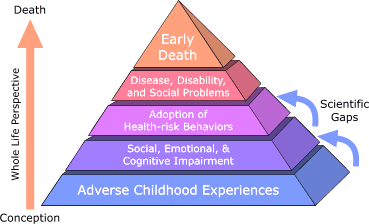
I love what you’ve written here, but AA doesn’t have a phenomenal success rate. In fact it’s less than 10%. Check out http://www.lancedodes.com for more info. New research reveals that when AA does work, it works because of the relationships that form within it. But abuses are widespread in AA: (http://www.the13thstepfilm.com), it’s got zero basis in science and it keeps people “counting days” with a threat of banishment and public shaming, frequently mirroring the dysfunctional families they grew up in.
I’m so sorry to hear your report. Unfortunately I’m not able to check into AA per se because I’ve got to focus on attachment and attachment disorder. I’d love to dialog with you on that! Please check out my book at http://attachmentdisorderhealing.com/book/
Pingback: The Hole in Me | "Don't Try This at Home"
Pingback: New Year Gratitude | "Don't Try This at Home"
Pingback: From the Butt End of Evolution | "Don't Try This at Home"
Thank you so much for always being there for me. I think I’m warming up for Dr. Phil…
Kathy
This is a remarkably informative article, exceptionally well written. Thank you for sharing these recent advances in the understanding of the human condition.